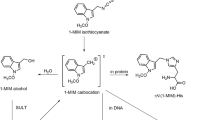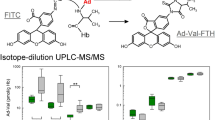Abstract
The assessment of the carcinogenic properties of aniline is still controversial. Aniline has, if at all, genotoxic properties but is also acutely toxic and it has been proposed that the hematotoxic effects are responsible for the formation of hemangiosarcomas and fibrosarcomas in the spleen of male rats. As part of a bigger project in which the pathology of male Fischer F344 rats was studied after feeding 10, 30, or 100 mg/kg body weight aniline hydrochloride for 1 and 4 weeks in the diet, the aniline–hemoglobin (Hb) adducts were determined as a biochemical effect marker during those periods. An improved method for the work-up procedure and the adduct analysis was developed for this purpose. The Hb adduct levels increased proportionately with dose after 1 week, which indicates that metabolic activation was not saturated. After 4 weeks of feeding, the adduct levels increased less than proportionately, which suggests that a saturation process is involved. Since it is unlikely that metabolic activation was saturated, the results could be explained by a more rapid clearance of stressed erythrocytes at the carcinogenic dose level. The latter interpretation is supported by other observations which indicate that erythrocytes are damaged dose dependently. A no-observed-effect level (NOEL) has not been reached but could be close to the low dose of 10 mg/kg body weight per day. The Hb adduct formation at the low dose, however, indicates that this should not be considered a no-effect level (NEL). The results support the conclusion that hemolytic anemia is an essential prerequisite for aniline toxicity and tumor development, but they do not fully explain the tissue specificity.





Similar content being viewed by others
References
Albrecht W, Neumann HG (1985) Biomonitoring of aniline and nitrobenzene. Hemoglobin binding in rats and analysis of adducts. Arch Toxicol 57:1–5
Berenblum I (1932) Aniline cancer. Cancer Rev 7:337–355
Birner G, Neumann H.-G (1988) Biomonitoring of aromatic amines II: Hemoglobin binding of some monocyclic aromatic amines. Arch Toxicol 62:110–115
Bryant MS, Skipper PL, Tannenbaum SR (1987) Hemoglobin adducts of 4-aminobiphenyl in smokers and nonsmokers. Cancer Res 47:602–608
Bulbulyan MA, Figgs LW, Zahm SH, Savitskaya T, Goldffarb A, Astashevsky S, Zaridze D (1995) Cancer incidence and mortality among β-naphthylamine and benzidine dye workers in Moscow. Int J Epidemiol 24:266–275
CIIT (Chemical Industry Institute of Toxicology) (1992) Final Report. 104-Week chronic toxicity study in rats, aniline hydrochloride. CIIT, Research Triangle Park NC
DFG (Deutsche Forschungsgemeinschaft) (2000) MAK- und BAT-Werte-Liste 2000, Senatskommission zur Prüfung gesundheitsschädlicher Arbeitsstoffe. Mitteilung 36. Wiley-VCH, Weinheim
Dölle B, Töpner W, Neuman H-G (1980) Reaction of arylnitroso compounds with mercaptans. Xenobiotica 10:17–35
IARC (International Agency for Research on Cancer) (1982) Monographs of the carcinogenic risk of chemicals to humans. Vol 27: some aromatic amines, anthraquinones and nitroso compounds, and inorganic fluorides used in drinking water and dental preparations. IARC Press, Lyon, pp 39–61
Khan MF, Green SM, Ansari GA, Boor PJ (1998) Phenylhydroxylamine: role in aniline-associated splenic oxidative stress and induction of subendocardial necrosis. Toxicol Sci 42:64–71
NCI (National Cancer Institute) (1978) Bioassay of aniline hydrochloride for possible carcinogenicity. CAS No. 142-04-1. Carcinogenesis Technical Report Ser. No. 130. US Department of Health, Education, and Welfare publication no. (NIH) 78-1385. US DHEW/PHS/NIH, Bethesda MD
Neumann H-G (2000) Protein-Addukte als biochemische Effekt-Marker für ein biologisches Monitoring. Arbeitsmed Sozialmed Umweltmed 35:428–432
Neumann H-G (2003) Zur Umstufung von monozyklischen N-substituierten Arylverbindungen der Krebs-Kategorie 3 der MAK-Werte-Liste. DFG (in press)
Neumann H-G, van Dorp C, Zwirner-Baier I (1995) The implications for risk assessment of measuring the relative contribution to exposure from occupation, environment and lifestyle: hemoglobin adducts from amino- and nitro-arenes. Toxicol Lett 82/83:771–778
Neumann H-G, Zwirner-Baier I, C van Dorp (1998) Markers of exposure to aromatic amines and nitro-PAH. Arch Toxicol Suppl 20:179–187
Parkes HG, Evans AEJ (1984) Epidemiology of aromatic amine cancers. In: Searle CE (ed) Chemical carcinogens, vol 1. American Chemical Society, Washington DC, pp 277–301
Rehn L (1895) Bladder tumors in Fuchsine workers. Arch Klin Chir 50:588–600
Walpole AL, Williams MHC, Roberts DC (1954) Tumors of the urinary bladder in dogs after ingestion of 4-aminodiphenyl. Br J Ind Med 9:255–263
Ward E, Carpenter A, Markowitz S, Roberts D, Halperin W (1991) Excess number of bladder cancers in workers exposed to o-toluidine and aniline. J Natl Cancer Inst 83:501–506
Wieland E, Neumann HG (1978) Methemoglobin formation and binding to blood constituents as indicators for the formation, availability and reactivity of activated metabolites derived from trans-4-aminostilbene and related aromatic amines. Arch Toxicol 40:17–35
Zwirner-Baier I (1992) Zum Biomonitoring von kanzerogenen Arylaminen und Nitroarenen: Analyse Hämoglobin-gebundener Metaboliten. Dissertation, Universität Würzburg.
Zwirner-Baier I, Neumann H-G (1994) Biomonitoring of aromatic amines IV: use of hemoglobin adducts to demonstrate the bioavailability of cleavage products from diarylide azo pigments in vivo. Arch Toxicol 68:8–14
Acknowledgements
The study was sponsored by BASF, Bayer and ICI. The authors declare that the experiments comply with current German and EU laws.
Author information
Authors and Affiliations
Corresponding author
Rights and permissions
About this article
Cite this article
Zwirner-Baier, I., Deckart, K., Jäckh, R. et al. Biomonitoring of aromatic amines VI: determination of hemoglobin adducts after feeding aniline hydrochloride in the diet of rats for 4 weeks. Arch Toxicol 77, 672–677 (2003). https://doi.org/10.1007/s00204-003-0473-8
Received:
Accepted:
Published:
Issue Date:
DOI: https://doi.org/10.1007/s00204-003-0473-8




